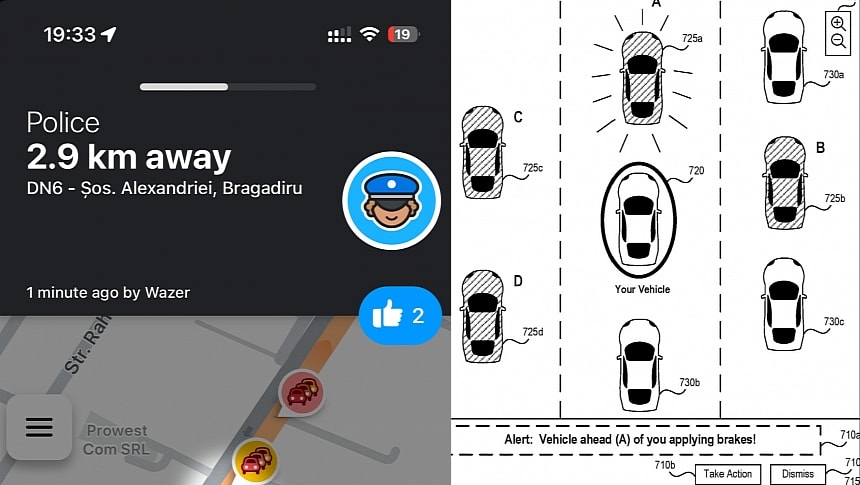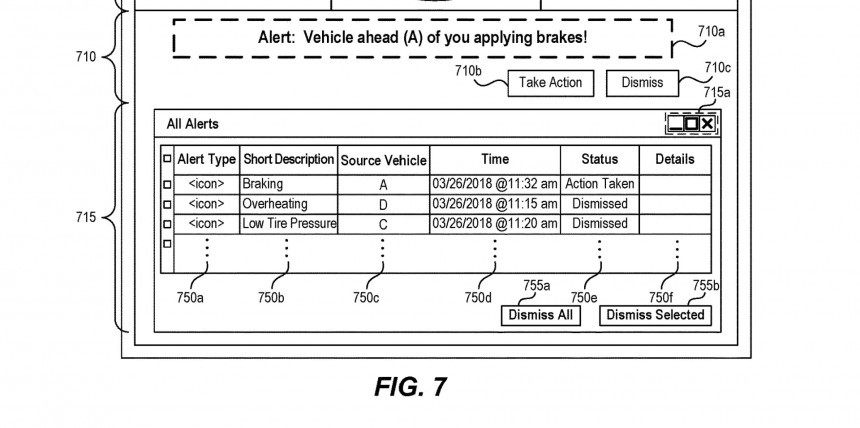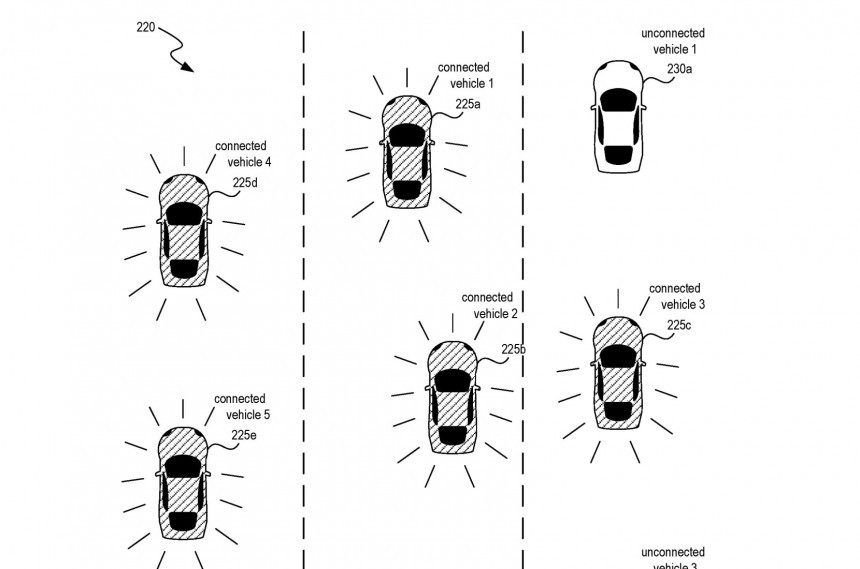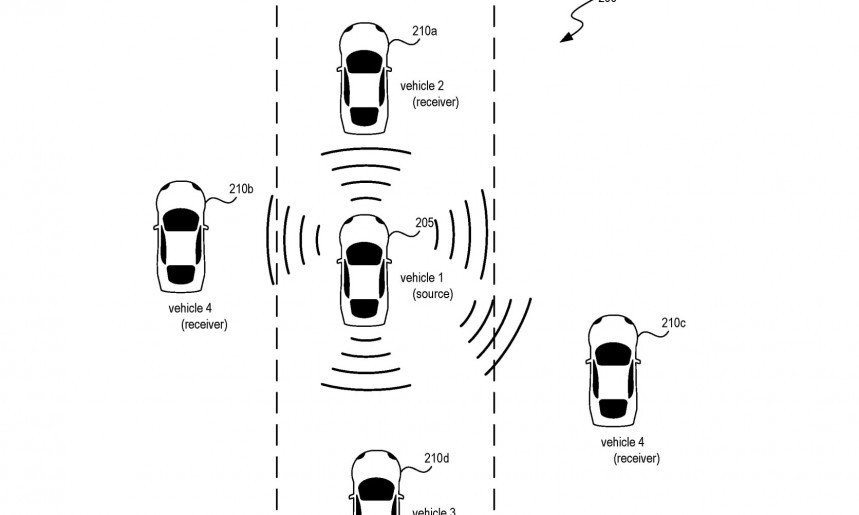I hate to state the obvious, but Waze has become a must-have driving companion for millions of drivers on the road thanks to its crowdsourced traffic reporting system.
It allows users to send traffic reports about what happens on the road. Waze uses this information to generate warnings for other motorists, providing them with more time to slow down when approaching hazards like accidents, potholes, speed traps, or blocked lanes.
Waze is one of the leading apps in the navigation space, and its gigantic user base makes this possible. Millions of users contribute with traffic data, helping the app understand what happens on the road and generate warnings that eventually make traffic safer for everybody.
A recent patent called "vehicle to vehicle event notification system and method" proposes a modern Waze system that wouldn't require any user action. It's all based on the hardware installed in the car, making the reporting system more straightforward and convenient for every vehicle on the road.
Before delving into the patent, it's important to understand how Waze works. Users running the app can submit reports on a wide range of hazards by tapping a dedicated "report" button on the app's main UI. The next step involves choosing the event type – this is where users can choose from speed traps, potholes, vehicles on the shoulder, blocked lanes, bad weather, roadkill, and other reports. Certain hazards come with extra options, such as police reports, where users can define where the speed trap is located. Users hit the submit button, letting Waze receive the report and generate warnings for other users approaching the flagged location.
The patent proposes a similar approach, but instead of users, it relies on what inventor Peter Kulakov calls "vehicle monitors." These monitors can be anything from cameras and sensors installed from the factory by carmakers to hardware that even users can connect to their vehicles, such as dashcams. Everything must be part of the same network to automatically identify hazards, report them to a system, and help generate warnings for other motorists.
The hazard detection is based on event triggers. This is where the automated technology becomes significantly more advanced than what Waze is capable of today.
The event triggers can be anything that could eventually impact traffic, such as a vehicle slowing down, causing a hazard for the next vehicles traveling behind it. Once the driver slams on the brakes (the inventor specifically mentions that the event would be triggered instantly when the brakes are engaged, faster than when the brake lights are activated), the reaction time for the following vehicles would be significantly reduced thanks to a generated warning.
However, because everything is based on hardware data, the system can also access more vehicle information, including vehicle health data, how hard the brakes were pressed, and other details that could eventually contribute to generating an appropriate warning.
Cameras and sensors installed on the vehicle can determine road hazards like potholes, emergency situations, road conditions, and roadworks, and mixed with how vehicles react to these hazards, a server can generate warnings that provide other vehicles with a clearer picture of what happens on the road.
Another big benefit of this system is who receives the warnings. For example, if a driver slams on the brakes, only the following cars would get a notification, as alerting all nearby vehicles, including the ones traveling on the other side, wouldn't make sense. Additionally, the system can rely on data collected from other sensors and vehicle hardware to understand why the driver used the brakes, eventually generating other hazard warnings that could target a bigger number of vehicles.
The major shortcoming is that this system relies on a universal service that would have to be installed by all carmakers in all cars. While third-party hardware, such as cameras and vehicle hardware, would also be supported, the vast majority of vehicles would require factory-installed systems to allow for efficient vehicle-to-vehicle communication to transmit hazard information in a timely manner.
The patent provides more information on how tech integration into the vehicle would be possible, explaining that a server could be in charge of prioritizing certain traffic warnings when multiple trigger events are detected. Based on event priority, the driver could be provided with different notifications. For example, if an accident happens ahead and the driver must react promptly, the system generates a high-priority warning, issuing audio and visual notifications.
Everything sounds great on paper, but integrating such a complex system on a vehicle could be costly and require an industry-wide effort that carmakers would have to contribute to. For now, this idea is still in the patent stage, so you'd better not hold your breath for its mass production.
The best thing you can do right now is use Waze and report traffic hazards when you see them. The more information the app has, the safer the road can become for everybody running it.
Waze is one of the leading apps in the navigation space, and its gigantic user base makes this possible. Millions of users contribute with traffic data, helping the app understand what happens on the road and generate warnings that eventually make traffic safer for everybody.
A recent patent called "vehicle to vehicle event notification system and method" proposes a modern Waze system that wouldn't require any user action. It's all based on the hardware installed in the car, making the reporting system more straightforward and convenient for every vehicle on the road.
Before delving into the patent, it's important to understand how Waze works. Users running the app can submit reports on a wide range of hazards by tapping a dedicated "report" button on the app's main UI. The next step involves choosing the event type – this is where users can choose from speed traps, potholes, vehicles on the shoulder, blocked lanes, bad weather, roadkill, and other reports. Certain hazards come with extra options, such as police reports, where users can define where the speed trap is located. Users hit the submit button, letting Waze receive the report and generate warnings for other users approaching the flagged location.
The hazard detection is based on event triggers. This is where the automated technology becomes significantly more advanced than what Waze is capable of today.
The event triggers can be anything that could eventually impact traffic, such as a vehicle slowing down, causing a hazard for the next vehicles traveling behind it. Once the driver slams on the brakes (the inventor specifically mentions that the event would be triggered instantly when the brakes are engaged, faster than when the brake lights are activated), the reaction time for the following vehicles would be significantly reduced thanks to a generated warning.
However, because everything is based on hardware data, the system can also access more vehicle information, including vehicle health data, how hard the brakes were pressed, and other details that could eventually contribute to generating an appropriate warning.
Another big benefit of this system is who receives the warnings. For example, if a driver slams on the brakes, only the following cars would get a notification, as alerting all nearby vehicles, including the ones traveling on the other side, wouldn't make sense. Additionally, the system can rely on data collected from other sensors and vehicle hardware to understand why the driver used the brakes, eventually generating other hazard warnings that could target a bigger number of vehicles.
The major shortcoming is that this system relies on a universal service that would have to be installed by all carmakers in all cars. While third-party hardware, such as cameras and vehicle hardware, would also be supported, the vast majority of vehicles would require factory-installed systems to allow for efficient vehicle-to-vehicle communication to transmit hazard information in a timely manner.
Everything sounds great on paper, but integrating such a complex system on a vehicle could be costly and require an industry-wide effort that carmakers would have to contribute to. For now, this idea is still in the patent stage, so you'd better not hold your breath for its mass production.
The best thing you can do right now is use Waze and report traffic hazards when you see them. The more information the app has, the safer the road can become for everybody running it.









